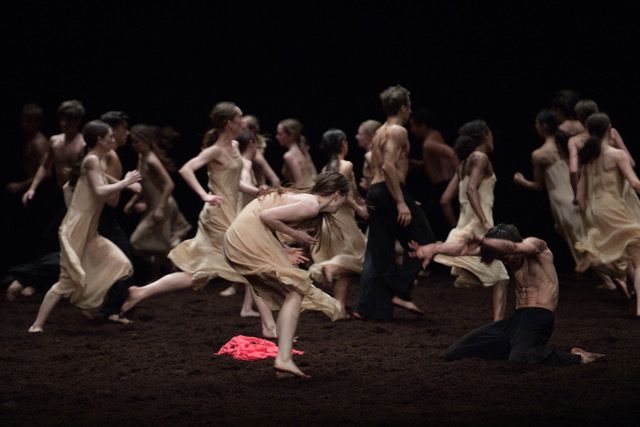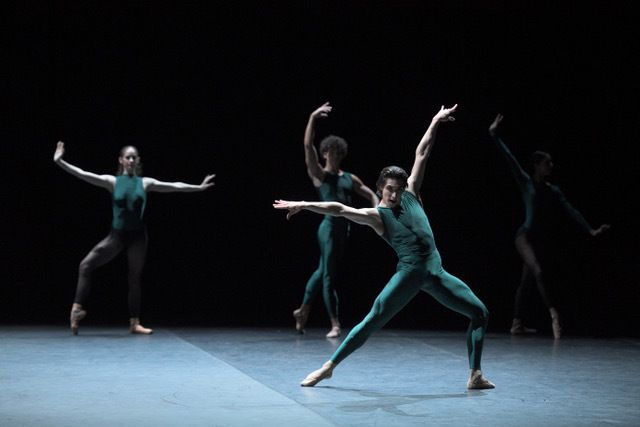A conclave of powerful men presides over the fate of a terrified woman.
So culminates Pina Bausch’s monumental reworking of The Rite of Spring, a ballet whose depiction of tribal human sacrifice harks back to the dawn of time.
But in 2017, it is the frightening familiarity of this image that packs a timely punch into this 1975 masterpiece. And in the daring and able hands of English National Ballet (ENB), it was the gut-punching standout in a program of works by 20th century masters.

Pina Bausch’s Rite of Spring.
The dread takes hold with the first oboe strains of Stravinsky’s iconic score, as the lights come up on a young woman in a nude shift lying face down on an earth-covered stage. Beneath her is a piece of red fabric that is later revealed to be a dress, to be worn by the “Chosen One” in a ritual human sacrifice to consecrate the arrival of spring.
First the women of the ballet’s tribe enter the stage, followed by an equal number of men. Bausch had a well-documented and critical interest in gender constructivism, and it shows in her choreography: while bare-chested men stride and leap with power and virility, the women are more fragile and passive, favoring low, trembling movements and inward-facing formations. They are fearfully cognizant of their inferior position in this tribe, and even more disturbingly, seem powerless to change it as the score inevitably propels the ballet to its macabre climax.
There are volumes that could be (and have been) written about Bausch’s Rite of Spring, both as a piece of dance theater and as a work of poignant social commentary. But noteworthy about this performance is that ENB is only the second ballet company, after Paris Opera, to have acquired the right to perform it. This is a major coup for artistic director Tamara Rojo, who has been hard at work delivering on her promise to transform the company’s repertory, with a welcome emphasis on works by female choreographers.
Most noteworthy, though, was the fearlessness with which ENB’s young dancers took on this powerhouse of a piece — particularly Crystal Costa as the terrified sacrificial virgin (the “chosen one”) and James Streeter as the cold and merciless “sage” who selects her. Respectful, but unafraid of this Rite of Spring’s massive artistic weight, the dancers don’t hesitate to get down and dirty with it — both literally and figuratively. As they pant audibly, shake visibly and their sweat mixes with earth, what brands the mind is not how they move, to paraphrase one of Bausch’s most famous quotes, but the deeper impulse that moves them, as people.
Unfortunately, this sense of attack was missing from the program opener, William Forsythe’s “In the Middle, Somewhat Elevated.” Although the company’s youthful energy proved an asset in the primal Rite of Spring, Forsythe’s sleek and relentless neo-classicism requires a level of maturity and confidence that many of the dancers are still developing. “In the Middle” is an exercise in controlled explosion, and it takes a diva to pull off the breakneck speeds and geometric precision of the choreography — only to walk off casually, like it was never a big deal in the first place. It was, after all, created for Sylvie Guillem.

Cesar Corrales in Forsythe’s “In the Middle, Somewhat Elevated.”
Still, what the dancers sometimes lacked in maturity, they made up for in guts, as well as a few standout performances. Charismatic and explosive, Cesar Corrales dazzled in his solo. Standing in for Lauretta Summerscales, the long-limbed and sinewy Tiffany Hedman could have been more confident, but has all the makings of a great Forsythian dancer.
Least memorable in the program was Dutch choreographer Hans van Manen’s “Adagio Hammerklavier.” Set to Beethoven’s slow and pensive sonata no. 19, the adagio features three couples clad in white. It’s restrained, elegant and structurally sophisticated, and it’s always a treat to see Tamara Rojo on stage. Sandwiched between Forsythe and Bausch, however, it felt not only bland, but disappointingly dated in an evening of works that have otherwise admirably stood the test of time.
Bausch / Forsythe / van Manen is running at Sadler’s Wells in London through April 1.
